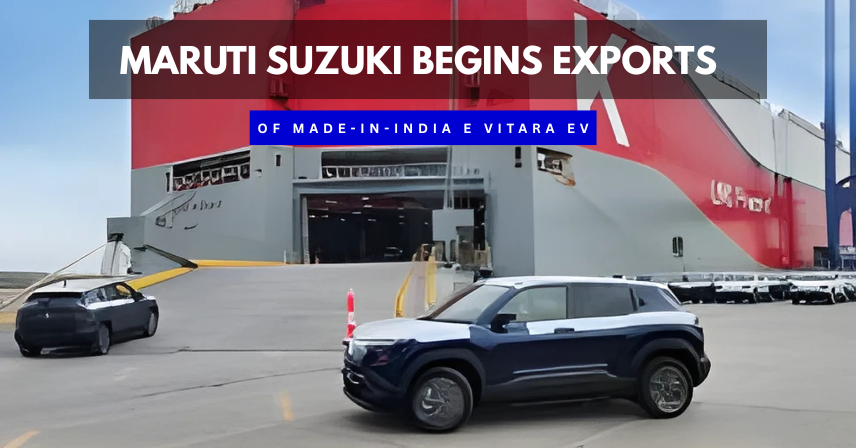Maruti Suzuki starts exports of its first made-in-India e VITARA EV. Explore features, global strategy, specifications, and what this milestone means for India’s EV market.
India’s automobile landscape has entered a new era as Maruti Suzuki, the country’s largest car manufacturer, officially begins exports of its first made-in-India electric SUV – the e VITARA EV. This milestone not only strengthens India’s position in the global EV market but also reflects Maruti Suzuki’s commitment to sustainable mobility and innovation.

In this blog, we will dive into every detail of the e VITARA EV – from its design, specifications, battery, and features to its global export strategy and what it means for India’s automobile industry.
The Beginning of Maruti Suzuki’s EV Journey
Maruti Suzuki has long been the backbone of India’s automobile industry. With models like Alto, Swift, and Vitara Brezza dominating the roads, the company now sets its sights on a cleaner, greener future.
The e VITARA EV is Maruti Suzuki’s first fully-electric SUV designed, engineered, and manufactured in India. What makes this development special is that exports have started even before its mass domestic launch – highlighting India’s potential to become a global hub for EV manufacturing.
Why the e VITARA EV Matters for India
- First Made-in-India EV SUV by Maruti Suzuki
– A direct contribution to India’s EV adoption roadmap. - Boost to Exports & Global Recognition
– Strengthens India’s reputation in the global auto supply chain. - Aligns with Government’s EV Vision 2030
– Supports the target of 30% electric vehicle adoption by 2030.
4.Affordable Yet Premium
– Maruti Suzuki is expected to price the e VITARA competitively, making EVs accessible for more customers.
Design & Styling of the Maruti Suzuki e VITARA EV
The design philosophy of the e VITARA EV combines modern aesthetics with SUV practicality.
- Bold Front Grille (Closed EV Design) – Smooth, aerodynamic look with signature LED DRLs.
- Sculpted Body Lines – Gives it a sporty stance while improving efficiency.
- Premium Alloy Wheels – Designed for both performance and aerodynamics.
- Spacious Cabin – Built on a wide SUV platform ensuring comfort for Indian and global customers.
Maruti Suzuki e VITARA EV – Specifications
While the final India-specific specs may vary, global versions of the e VITARA EV being exported are expected to carry the following key specifications:
- Battery Pack: 60–65 kWh lithium-ion
- Range: 450–550 km on a single charge (WLTP cycle)
- Motor Output: Approx. 140–160 HP
- Torque: 250–300 Nm
- Charging:
- Fast Charging: 0–80% in 50–60 minutes
- Standard AC Charging: 7–8 hours
- Drive Modes: Eco, Normal, Sport
Safety Features: 6 airbags, ABS with EBD, ADAS (Advanced Driver Assistance Systems), and regenerative braking.
Interiors & Technology
Step inside the e VITARA EV, and you’ll experience a blend of technology and comfort.
- 10.25-inch Touchscreen Infotainment System with Android Auto & Apple CarPlay.
- Digital Instrument Cluster with EV-specific readouts like battery percentage, range, and charging info.
- Connected Car Technology with smartphone integration.
- Ventilated Seats & Panoramic Sunroof for premium comfort.
Wireless Charging & Multiple USB-C Ports for modern convenience.
Global Export Strategy
Maruti Suzuki has chosen to export the e VITARA EV first, before the official India launch. The SUV will be shipped to markets such as Europe, Japan, and select ASEAN countries, where demand for EVs is already strong.
This strategy serves two purposes:
- Brand Value: By showcasing its EV in developed markets, Maruti Suzuki enhances its global image.
- Testing & Feedback: Customer response in global markets helps fine-tune the model for Indian buyers.
Impact on Indian EV Market
The launch and export of the Maruti Suzuki e VITARA EV signals a shift in India’s EV ecosystem.
- Boosts Local Manufacturing: More suppliers and vendors get integrated into the EV supply chain.
- Competitive Market: With Maruti entering, rivals like Tata Nexon EV, MG ZS EV, and Hyundai Kona will face stiffer competition.
- Affordable Options for Consumers: Maruti’s scale ensures cost-effectiveness, potentially making EVs cheaper.
- Job Creation & Economy Growth: Export demand drives employment and boosts India’s manufacturing GDP.
Maruti Suzuki vs Competitors
| Feature | Maruti e VITARA EV | Tata Nexon EV | MG ZS EV | Hyundai Kona EV |
| Range (km) | 450–550 | 465 | 461 | 452 |
| Battery Size (kWh) | 60–65 | 40.5 | 50.3 | 39.2 |
| Fast Charging (0–80%) | 50–60 mins | 60 mins | 60 mins | 57 mins |
| Price (Expected) | ₹22–25 Lakh | ₹14–19 Lakh | ₹23–27 Lakh | ₹24–25 Lakh |
Government Support & EV Policy
India’s government is actively promoting EV adoption through FAME II subsidies, PLI schemes, and tax rebates on EV loans. Maruti Suzuki’s move aligns perfectly with this policy framework, giving Indian customers more confidence to switch from petrol/diesel to electric mobility.
Challenges Ahead
While the e VITARA EV marks a strong beginning, challenges remain:
- Charging Infrastructure: Still limited in many parts of India.
- Battery Costs: High costs may affect pricing.
- Consumer Awareness: Many customers remain hesitant about EV technology.
However, with Maruti Suzuki’s brand trust and government initiatives, these challenges are expected to reduce over time.
Conclusion
The Maruti Suzuki e VITARA EV export marks a landmark moment for India’s automobile industry. It shows how far the country has come—from being a mass small-car producer to becoming a global EV exporter. With competitive pricing, robust features, and international recognition, the e VITARA EV is set to redefine India’s position in the global electric vehicle market.
As we move toward a greener future, Maruti Suzuki’s bold step will inspire not only car buyers but also other manufacturers to invest heavily in EV innovation.
👉 For more updates like this visit www.carbikebhp.com

